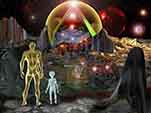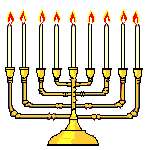Have you ever met a person and they seemed to suck the energy right out of you? Most of us have. Energy suckers can be vampires too. I've had these articles on holidays and monsters since before Halloween but didn't get around to posting them up.
Hope everyone has been enjoying the fall.
Para
================
Sumerian Vampires
Vampires are a subject that has fascinated many people through the centuries. This is particularly true among people interested in ancient Sumer. A number of books have touched upon the topic, but none have gone greatly into depth on the subject. The reason for this is that vampires are not a particularly dignified subject for Assyriologists to focus upon. Neo-pagans on the other hand have the interest, but tend not to be qualified to write much on the subject.
The Sumerians obviously did not have the word vampire. This would come much later in a region somewhat to the north that would have had no contact with the Sumerians, but who might have had contact with the descendants of the Sumerians. They did however have the concept of demonic creatures that consumed the blood of the living.
The concept of a vampire is a vague one. It is agreed in some circles that a mythological creature is a vampire if they drink blood. On the other hand a lion will readily drink blood. Sometimes cannibalistic creatures are lumped in with vampires. The main difference here is that these drink the blood of the dead rather than the living.
Confusingly it is not agreed upon in all circles that a vampire needs to drink blood. Some creatures that draw energy from individuals are also categorized as vampires. These creatures are definitely parasitic, but are they vampires?
Nergal
In form, this god is strong and powerful. He is sometimes described as a warrior, and other times described as a dragon. He is always described as having horns, but this is universal across all middle eastern gods, not just Nergal in particular. Being an underworld god he has some bird like characteristics. These would chiefly include claws.
Nergal is best known as an underworld god, but he worked his way slowly up to that point. He started out as a guardian of the underworld standing next to his twin brother. The image of Nergal and his brother was remembered when the Babylonians developed astronomy, and is still remembered today as the Greek constellation of Gemini.
The chief duty of the twins would have been to cut to pieces any, be they mortal, ghost, demon or god, who attempted to force their way into the underworld. They would likely have stood in front of the gates of the fortress of Ganzer.
Interestingly this might not be the only time that the Greeks adopted Nergal for their astronomy. After Nergal's time as a guardian of the gates of the underworld he became a war god. Here he led demons and mortals in battle against their enemies. As such he was a god of disease and plagues, leading his demons in bloody battles just as he led mortal leaders.
It is as a war god that we have some of our best evidence of blood offerings. Here he is described as being a dragon covered in gore who drinks the blood of the living. Elsewhere in the texts he is said to be offered secret blood rituals.
He is perhaps better known as a war god by his Akkadian / Babylonian name Erra. There are strong arguments that he might have inspired the Greek Aries, though there is no doubt that the Greek god was a rather different god from the Mesopotamian one. For their star charts, the Greeks adopted the Babylonian star charts almost whole cloth. As such the constellation of Aries at least peripherally remembers Nergal.
After the death of the bull of heaven, Ereshkigal, queen of the underworld, took Nergal as her husband. There is obviously more to this story, an entire myth in fact, but from a vampiric point of view what matters is that Nergal refused to bow down before death, and that he became the second most powerful individual in the underworld. What this means is that it is he who leads the undead and blood drinking ghosts.
The Dead
When a mortal dies they are placed in a grave along with several statues. The grave provides a gate for the dead and these statues to physically enter Kur, the underworld. Once in the Kur the statues and the dead are given motion and substance.
The dead must pass through seven gates as they travel into the underworld. Once there they can be granted residence in the great city of Urugal, reside in the wasteland like areas, or anywhere in between. The underworld was not considered the ideal place to be. The worst parts could be very bad indeed. The Greek idea of Hades can be linked to the Sumerian underworld.
Don't think of this as heaven and hell. The worst areas are not set aside for evil doers, but are rather set aside for those who did not properly prepare themselves for the afterlife. This area was not a punishment, but rather a bad place to be. Likewise the city of Urugal was the home of Ereshkigal and those who worked diligently in the service of the gods. Unlike the link between Hades and Kur, there is no evidence of any connection between the Elysian Fields and the great city of Urugal.
Once in the underworld, the dead could, through extraordinary circumstances, return to the living. Should this happen, they will be returned to life as vampires. There are a small handful of myths involving the underworld where the gates of Ganzer are threatened from within or without. It is from here that we learn something of the vampiric nature of the dead.
The true threat of this is that the dead would pour out in numbers greater than the living. This number would be increased by the statuary servants buried along with them. They would consume the blood of the living and, with the gates open, increase their numbers this way.
The thirst for blood here is a way to retain a link to the land of the living. The dead of the poorer portions of the underworld are also said to consume dirt. This is likely a link to the grave, and the eternal sustenance of the dead.
Occasionally the dead are not able to make it into the underworld. A demon might cause the body to fail, but it might fail in its effort kill them. This now presents a body in a grave that is not truly dead. It has a trapped soul and a trapped demon.
This would be the perfect recipe for a Sumerian vampire. They might feed upon blood to retain a connection to the living. They might also seek to possess and kill a victim in order to hitch a ride into the underworld when they are buried. They might even have unfinished business with the living world.
Gidim
Their name can be translated to encroaching darkness, hungry ghost, demon, or a hand full of other similar titles. The specifics are different, but the general points are the same. These are spirits who have the ability to consume the living in some way.
Not all dead who return to drink the blood of the living do so as a physical being. Gidim are walking shadows that consume the living leaving bruising upon the neck. They can possess a mortal by entering the ear, and so powerful charms are occasionally placed upon earrings to protect against them.
Gidim are ghostly demons who are often prevented from entering the land of the dead for one reason or another. This might be simply because they cannot offer gifts to each of the gate keepers, or be something far worse such as a profound hatred of some or all of the living. The journey back to the land of the living is difficult, but it can be done by a determined spirit, or on certain sacred days.
Not all Gidim are hostile towards the living. In the month of Ne Izi Gar ghosts return to the land of the living to visit their departed loved ones. They are welcomed with a number of festivals at this time. Also at this time the Gidim of hostile sorcerers are said to return. These ghosts can take the living and cause them several kinds of harm.
Two things seem to separate good Gidim from harmful ones. The harmful ones drink blood, and stay around longer. This makes sense when you consider that the dead need blood, the essence of life, to retain a link to the world of the living.
A final thing that should be remembered when looking at the Gidim are the sorcerers. These fall under those capable of great harm. They are certainly considered to have powerful spirits, but they can't be considered to be universally harmful. In their way they typify all Mesopotamian demons. They are not good or evil by nature, but rather do what they do because of who they are as individuals.
Galla
These demons were never alive. Not in the same way as mortals that is to say. They have no concept of mercy, and cannot be bribed. They do have a concept of justice however. Their goal seems to be to get as many dead for the underworld as they can by whatever means they can.
This form of demon may not have a concept of mercy, but they do know the meaning of justice. Their duty is to maintain the laws of the underworld by whatever means they can. It is their duty to prevent physical escapes from the underworld, to maintain the laws protecting the rights of the dead in the underworld, and carry out the will of Ereshkigal.
Initially it would seem that these demons would be against anything vampiric, however according to at least one professional Sumerian linguist they do exhibit vampiric characteristics. This is backed up by their behavior in the myth of the death of the god Ningishzida. Also, as underworld demons, they are going to gain vampiric characteristics simply by association.
Galla have been described as manifestations of the underworld itself. Being pieces of Kur would, in a way, make them undead. This interpretation is debatable however, as the Sumerians didn't share the Hindu concept of aspects.
The Galla demons are occasionally rebellious. They were breaking the law of the gods in the aforementioned Ningishzida myth. They were promptly punished for their transgression. Even so, when they were doing their job, they were valued members of the community.
Galla demons were not considered to be lesser demons in any way. They were dangerous, and occasionally rebellious. In a way they were something like bounty hunters. Even so, they were one of a few types of demon that were welcome to eat at the table of Enlil.
Maskim [Mashkimu]
Like the Galla, Maskim were underworld demons. Like the Galla, they were integral in the upkeep of the laws of the underworld. Unlike the Galla, they were tied more closely to the laws of the underworld than to the underworld itself.
Maskim is not actually their proper name. It was an early translation used, presumably by Simon, in modern necromantic texts. Their name would more properly be pronounced Mashkimu. They are not Lovecraftian, but they would be at home in the Cthulhu mythos.
Unlike many other vampiric creatures, the Maskim do not need to resort to sneaking up on their prey. Maskim can simply rip down the walls of a house and consume all that they find inside. They are demons of a much higher order than their underworld kinsmen.
The word Maskim literally translates to 'inspector', referring to their duty as netherworld overseers. It is their job to make sure that the laws of the underworld are obeyed even by other demons. The Galla have been known from time to time to do things that serve the will of the underworld itself above the proper order of the universe as set forth by its ruler and the other gods.
Like anything else with too close a relation to the underworld, they came to have vampiric traits. It should be noted that they were only mentioned as drinkers of blood in the later Babylonian texts. This means that their blood drinking characteristics might have actually been a blurring of the lines between Galla demons and the Mashkimu.
As with the Galla, the Mashkimu were welcome to eat at the table of Enlil. This is interesting as Enlil was the head of the pantheon and not an underworld demon at all. He was in fact a wind god associated more with spirits of the air.
Lilith and Lilitu demons
Lilith is perhaps the most famous of the Mesopotamian demons. She is presently associated with white wolf games, an all female rock concert, immorality among Jewish women, and a few other things here and there. The Lilith we have any evidence of is something more.
Lilith is the Babylonian name simply identifying her as a specific Lilitu demon. Lilitu demons first show up in the Gilgamesh myths. In the Sumerian version of these myths no specific demoness is mentioned, but in the later Babylonian versions she is always called Lilith.
She is a Lilitu demon, but what is a Lilitu demon? Lilitu demons tell us a lot simply in their name. "Lil" means wind, "itu" means moon. Moon wind together, however, means owl. The Mesopotamian screech owl is a creature that glides silently on the wind with a moon like, disturbingly human, face. They are disturbingly large and carry off the young of various creatures.
In Gilgamesh, the Liltu demoness was living in a tree and acting much like a harpy. This type of wind spirit is a female who preys upon the lives of babies and expecting mothers. Gilgamesh frightened it away with his enchanted Ax of the Road after killing a snake monster.
Lilitu were one group of a triumvirate of demons. Lilitu and Ardat Lili, meaning maiden lilu, are female groups of demons, and Lilu are male. Each of them preys upon a select type of victim. The shared lil prefix in each of their names tells that they are each wind demons.
When Abraham left the city of Ur in the eighteenth century BCE or potentially slightly earlier, he took some of these myths with him. Lilith became known as the first wife of Adam in this version. She wished to be dominant over him in the bedroom and was punished.
In this version, Lilith was told that she would have her demon children killed in mass numbers. By kidnapping human children and letting them be killed instead, she can protect her children. This story had a moral in it. It told women that terrible things can happen if they weren't so submissive to their men. It also encouraged protection of children from Lilith.
So what does all this have to do with vampires? Nothing actually. In Assyriology there is one name that comes to the top of any work on Assyriology, and that name is Kramer. In his early work he translated Lilith as being a vampire. It is an easy mistake to make, as there were quite a few vampire demons in Mesopotamia. This translation was proven false by the only translator who was better than the early work of Kramer. The later work of Kramer corrected the mistake in translation.
Assyriology is a relatively obscure field, so how did Lilith get associated with vampires? It happened with the publishing of the world of darkness role playing games by Whitewolf™. You know the "No role play" rule in most vampire communities? Same thing. Someone must have read the obscure little line in one of Kramer's books.
In white wolf's game books Lilith was the supernatural creature that cried blood and turned Cane brother of Able into a vampire. There are any number of things wrong with this from the point of view of biblical theology, but white wolf produced games and not theology text books. This last fact is sadly news to some people. [editors note: Most role play manuals make poor source material for any mythology – so please, consult actual mythological source books.]
Lamashtu and Pazuzu
For the most part demons are not inherently evil. They usually serve a valuable place in the order of the universe. A demon of the underworld might serve to cause people to die, but also serve to usher them into the underworld, or protect the rights of the dead.
Lamashtu was different. She was not doing harmful things because they needed to be done. She also did not do helpful things. She did what she did because she wanted to do harmful and destructive things. She didn't act on the behest of the gods, but acted on her own initiative. Although the Sumerians did not have the concept of individuals who were evil by their very nature, she would have come close.
Lamashtu was not strictly a vampire. Like Lilith, she was primarily a being who attacked women and infants. There is one text amongst the early incantations that mentioned the drinking of the blood of infants. On the other hand she also strangles babies and causes chaos.
She was not specifically a demon either, but more of a particularly old goddess associated with causing destruction. She was the daughter of An, making her a sister to the head of the pantheon. She even had children of her own in the underworld.
Her nemesis was the protective demon like god Pazuzu. He was a fearsome looking demon with claws and wings who protected pregnant women and their babies. He was one of many protective demons, and one of the more powerful ones.
Pregnant women would wear images of him around their necks above their wombs to protect against Lamashtu. For some reason the creators of the Exorcist films decided to use him for their intrinsically evil demon. Bad research strikes again.
Montague Summers' Muttaliku
The word Muttaliku, according to Montague Summers roughly a hundred years ago, is an interesting word that means wanderer. He mentions it once in his entire book on Vampires. Thanks to his single mentioning of the word, it has shown up on many lists of vampires with just as oblique a reference. Usually something along the lines of Muttaliku, an Assyrian form of vampire.
The trouble is Summers did not list his source text. Modern scholarly texts would have done this and as such be a better resource for those who would have more information later. That is the nature of scholarly sources. They are only useful if they build upon what has come before and help those who will come after.
The late nineteenth and early twentieth century was a different era for the study of ancient near eastern texts. Muttaliku might actually be vampiric in nature, but it is nearly imposable to tell because the word Muttaliku itself is a bad translation.
Let us take the term Akhkharu. This is another word that tends to be translated as a type of vampire. It's supposed to be a middle eastern word, but it sounds rather Egyptian. Akh is ancient Egyptian for a sort of spirit, and kharu is similar to an Egyptian word for one of their neighbors. This might make it an Egyptian word for foreign ghosts or demons. The trouble is that there is no basis for this interpretation.
Ahhazu might be a much better translation of the word. Even that translation might be a misinterpretation. Ahhazu is an obscure Mesopotamian demon or type of demon that may or may not have consumed blood.
The trouble with using old texts is that there is a difference between an ancient text, and an outdated translation of an ancient text. Even a good translation of a confusing text might be hard to understand.
Sometimes old sources are the only things that are available. When they aren't it is important to get up to date translations and to look in scholarly sources. They might be a little dry to read at times, but they are far more rewarding to read if you are seeking information.
The Month of Ghosts
In the Sumerian calendar there is one month where the dead have another shot at visiting the land of the living. This is Ne Izi Gar, the Month of Ghosts, the month when torches are lit. It is an important festival month when a special gate opens up to allow the dead to visit the living.
Traditionally a meal would be prepared with an empty chair for the dead to come to visit. This would be a happy occasion. The dead would be honored and given a feast, and there would be other little events that would occur through the month.
There was also a down side to having a vast number of ghosts around. Not all those that die are missed. Some of the dead were feared and dreaded in life. Some of those who were feared and dreaded retained a measure of this power in death. They had enemies who still walked among the living and the ability to do them harm.
Once a year, roughly in August according to the Nippurian calendar, these dead would be released to do harm to the living. There were special precautions that could be taken at this time to prevent the harmful effects of ghosts. Special ear jewelry was used to ward off possession, and special spells could be used to banish ghosts that were more feared.
A word on the laws of hospitality
The Sumerian pantheon is rather unique in that there is a highly organized social structure among the gods and demons. There is even a code of laws that are punishable with various levels of severity. One of the most important of these laws is hospitality. This is the law that protects a mortal and their guests within their own home from various forms of harm.
In the mortal world hospitality means that a host must provide for their guest, and that the guest must behave themselves in the home of the host. Typically the host must feed and protect their guest, and the guest must never ask for anything. Interestingly a host who has granted hospitality to a hated enemy will protect them from any kind of harm.
Gods and demons also observe this in various ways. Demons, including vampires, must ask permission to enter a home. If they offer hospitality they will not be able to harm their guest so long as the guest observes the rules.
The laws of the gods and the demons are strictly enforced with various checks and balances. This ties in to the most famous bane of vampires: Sunlight. Utu was the patron god of the sun. This doesn't mean that the Sumerians thought that he was the sun, simply the god of it. Utu, Shamash in Akkadian, was also the god of law and justice.
Not all undead, blood drinking ghosts, and blood drinking demons, are breaking the laws set forth by the gods, but many are. If they come out during the day and are hit by a beam of sunlight, then they will be seen by Utu. It should also be noted that Utu is one of the seven who decree fate, and as such one of the seven most powerful gods in the entire pantheon.
As such it has nothing to do with good or evil per say, more something to do with legal violations. Should a demonic creature be given what they want, let us say blood, legally, then there will be no problem at all. If on the other hand a Galla demon were to try to take someone's life who wasn't supposed to die, then they might be punished in kind.
Sources
"Gods, Demons, and Symbols of Ancient Mesopotamia" J Black, and A Green
"The Sumerians" SN Kramer
"Vampires, their Kith and Kin" M Summers
"Early Incantations and Rituals" Van DiJk and Hussey
"The Image of the Netherworld in the Sumerian Sources" D Katz
"Myths From Mesopotamia" Edited by S Dalley
Further reading
"Forerunners to Udug Hul, Sumerian Exorcistic Incantations" MJ Geller (If you can FIND it!)
http://www.templeofsumer.org/share4a.html






































